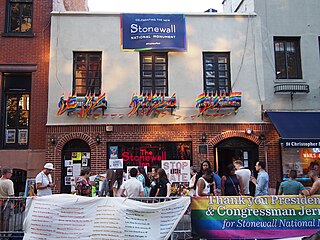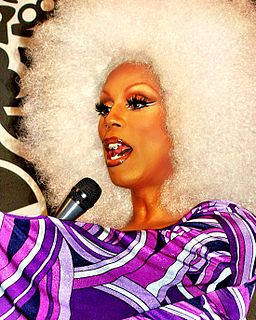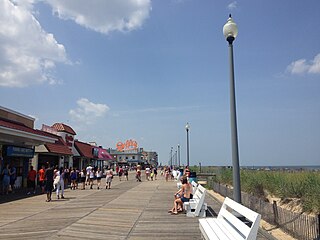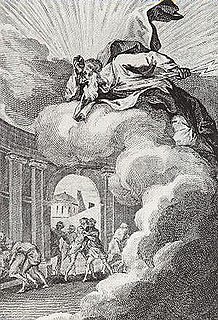 W
WLGBT history dates back to the first recorded instances of same-sex love and sexuality of ancient civilizations, involving the history of lesbian, gay, bisexual and transgender (LGBT) peoples and cultures around the world. What survives after many centuries of persecution—resulting in shame, suppression, and secrecy—has only in more recent decades been pursued and interwoven into more mainstream historical narratives.
 W
WThe history of bisexuality is divided into two parts, pre-modern history and contemporary history. The ancient and medieval history of bisexuality consists of anecdotes of sexual behaviors and relationships between people of the same sex and of different sexes. The modern definition of bisexuality started to take form in the 19th century. Today, the term bisexual is defined as a person who is sexually and/or romantically attracted to both males and females, or as a person who is sexually and/or romantically attracted to people of any sex or gender identity, which is sometimes termed pansexuality. The first English-language use of the word "bisexual", in the sense of being sexually attracted to both women and men, was by the American neurologist Charles Gilbert Chaddock in his 1892 translation of the 7th edition of Krafft-Ebing's seminal work Psychopathia Sexualis. Prior to Krafft-Ebing, "bisexual" was usually used to mean having both female and male parts as in hermaphroditic or monoicous plants, or to mean inclusive of both males and females as in the sense of mixed-sex education.
 W
WGay balls, cross dressing balls or drag balls, depending on the place, time, and type, were public or private balls, celebrated mainly in the first third of the twentieth century, where cross dressing and ballroom dancing with same sex partners was allowed. By the 1900s, the balls had become important cultural events for gays and lesbians, even attracting tourists. Their golden age was during the Interwar period, mainly in Berlin and Paris, even though they could be found in many big cities in Europe and the Americas such as Mexico City and New York City.
 W
WA gay icon is a public figure who is highly regarded and beloved by the LGBT community. A gay icon can either be a part of the LGBT community or heterosexual, but heterosexual gay icons are often highly supportive of their fans within the community and the rights of LGBT people. Organizations such as GLAAD routinely recognize public figures for their contributions and support for the LGBT community. Gay icons exist across cultures, most prominently in North and South America, Europe, and Asia.
 W
WChristian leaders have written about homosexual male–male sexual activities since the first decades of Christianity; female–female sexual behaviour was almost entirely ignored. Throughout the majority of Christian history most theologians and Christian denominations have viewed homosexual behavior as immoral or sinful.
 W
WA drag queen is a person, usually male, who uses drag clothing and makeup to imitate and often exaggerate female gender signifiers and gender roles for entertainment purposes. Historically, most drag queens have been men dressing as women. In modern times, drag queens are associated with gay men and gay culture, but they can be of any gender and sexual identity.
 W
WThe Christian tradition has generally proscribed any and all noncoital genital activities, whether engaged in by couples or individuals, regardless of whether they were of the same or different sex. The position of the Roman Catholic Church with regards to homosexuality developed from the writings of Paul the Apostle and the teachings of the Church Fathers. These were in stark contrast to contemporary Greek and Roman attitudes towards same-sex relations which were more relaxed.
 W
WIntersex, in humans and other animals, describes variations in sex characteristics including chromosomes, gonads, sex hormones, or genitals that, according to the UN Office of the High Commissioner for Human Rights, "do not fit typical binary notions of male or female bodies". Intersex people were historically termed hermaphrodites, "congenital eunuchs", or even congenitally "frigid". Such terms have fallen out of favor, now considered to be misleading and stigmatizing.
 W
WA lesbian bar is a drinking establishment that caters exclusively or predominantly to lesbian women. While often conflated, the lesbian bar has a history distinct from that of the gay bar.
 W
WThe development of LGBT culture in Philadelphia can be traced back to the early 20th century. It exists in current times as a dynamic and diverse culture with establishments and events held to promote LGBT culture and rights in Philadelphia and beyond.
 W
WLesbian, gay, bisexual, and transgender (LGBT) social movements are social movements that advocate for LGBT people in society. Social movements may focus on equal rights, such as the 2000s movement for same-sex marriage, or they may focus on liberation, as in the gay liberation movement of the 1960s and 1970s. Earlier movements focused on self-help and self-acceptance, such as the homophile movement of the 1950s. Although there is not a primary or an overarching central organization that represents all LGBT people and their interests, numerous LGBT rights organizations are active worldwide. The earliest organizations to support LGBT rights were formed in the early 20th century.
 W
WIn the post-Stonewall era, the role of libraries in providing information and services to LGBTQ individuals has been a topic of discussion among library professionals. Libraries can often play an important role for LGBTQ individuals looking to find information about coming out, health, and family topics, as well as leisure reading. In the past 40 years, advocate organizations for LGBTQ content in libraries have emerged, and numerous theorists have discussed various aspects of LGBTQ library service including privacy concerns, programming, collection development considerations and librarian/staff education needs, as well as special services for juvenile and teen patrons.
 W
WPink capitalism is the incorporation of the LGBT movement and sexual diversity to capitalism and the market economy, viewed especially in a critical lens as this incorporation pertains to the LGBT, Western, white, and affluent, upper middle class communities and market.
 W
WPride House is a dedicated temporary location which plays host to lesbian, gay, bisexual and transgender (LGBT) athletes, volunteers and visitors attending the Olympics, Paralympics or other international sporting event in the host city. The first was organized for the Vancouver 2010 Winter Olympics.
 W
WQueers in History is an encyclopedia written by Keith Stern of historically prominent people who were lesbian, gay, bisexual, or transgender (LGBT).
 W
WRehoboth Beach is a city on the Atlantic Ocean along the Delaware Beaches in eastern Sussex County, Delaware, United States. As of the 2010 United States Census, the population was 1,327, reflecting a decline of 161 (11.2%) from the 1,488 counted in the 2000 Census. Along with the neighboring coastal city of Lewes, Rehoboth Beach is one of the principal cities of Delaware's rapidly growing Cape Region. Rehoboth Beach lies within the Salisbury metropolitan area.
 W
WThe connection between left-leaning ideologies and LGBT rights struggles has a long and mixed history. Prominent socialists who were involved in early struggles for LGBT rights include Edward Carpenter, Oscar Wilde, Harry Hay, Bayard Rustin, Emma Goldman and Daniel Guérin, among others.
 W
WSodomy or buggery is generally anal or oral sex between people or sexual activity between a person and a non-human animal (bestiality), but it may also mean any non-procreative sexual activity. Originally, the term sodomy, which is derived from the story of Sodom and Gomorrah in the Book of Genesis, was commonly restricted to anal sex. Sodomy laws in many countries criminalized the behavior. In the Western world, many of these laws have been overturned or are not routinely enforced.
 W
WThe transgender rights movement is a movement to promote transgender rights and to eliminate discrimination and violence against transgender people regarding housing, employment, public accommodations, education, and health care. In some jurisdictions, transgender activism seeks to allow changes to identification documents to conform with a person's current gender identity without the need for sex reassignment surgery.